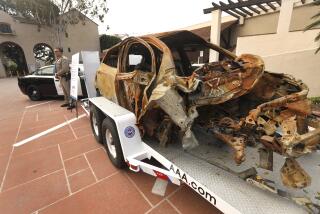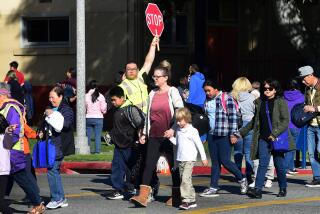Is it a safer call?
- Share via
YOU KNOW the shot: Seen from above, the hero (or villain) is hurtling down the freeway, top down, one hand on the wheel and the other clutching a cellphone to his ear. It’s Hollywood’s image of how deals are made, dates are broken and gossip is shared, at 65 miles per hour.
On Tuesday, that shot will be history. California motorists -- as well as those in Washington state, where a similar law was recently passed -- will be prohibited from talking on hand-held cellular phones while driving. Most, however, will likely continue their wireless business using headsets, speakers or other hands-free devices.
Gov. Arnold Schwarzenegger says the new law will reduce accidents. “Getting people’s hands off their phones and onto their steering wheels will save lives and make California’s roads safer,” he said earlier this month.
That, however, is not what the research finds. Scientists say that when mixing cellphones and driving, the number of hands available for the tasks is not the limiting factor.
Instead, it’s a driver’s attention and processing capacity. These are often stretched beyond safe limits when someone juggles the complex tasks of negotiating traffic and conversing with another remotely.
Worse than being drunk
“There are limits to how much we can multi-task, and that combination of cellphone and driving exceeds the limits,” says David Strayer, a University of Utah psychologist who has found that by many measures, drivers yakking on cellphones are more dangerous behind the wheel than those who are drunk, whether the conversation is carried on by handset or headset.
In a 2005 study, published in the journal Human Factors, Strayer put 41 adult drivers through four sessions in a simulator, re-creating realistic driving conditions along a 24-mile stretch of freeway.
Over three days, the subjects took the wheel in various ways: sober and off-the-phone; legally under the influence of orange-juice-and-vodka cocktails; while talking with a research assistant by hand-held cellphone; and chatting over a hands-free cellphone device. The result: Compared with drivers exceeding the legal blood alcohol limit, users of cellphones -- hand-held or hands-free -- reacted 18% more slowly to braking by the car in front and were more likely to get in a rear-end collision.
What’s more, the talkers seemed to compensate for their slowed response time by falling farther behind the car in front -- a pattern likely to slow traffic and exacerbate congestion.
“And you don’t get any better with practice,” Strayer adds. In his lab, subjects who reported they use a cellphone a lot when driving “show every bit as much impairment” than those who do so infrequently.
Although no studies looked at the safety of cellphone chatter by drivers of manual-transmission cars, Strayer acknowledged that stick-shifters may reap immediate safety improvements by switching to a hands-free device for cellphone calls. But he cautions that, in principle, that would merely bring these motorists up to “the same level of impairment” as automatic-transmission drivers talking on cellphones.
He says cellphone bans that exempt hands-free devices “are half-measures that aren’t really taking into account the available scientific evidence. And it’s not just one source of evidence,” he adds; in recent years, dozens of studies, using a wide range of methods, have concluded there is no difference between driving performance of people using hand-held phones and hands-free devices.
For instance, in a 2005 Australian study published in the British Medical Journal, researchers interviewed, during a 27-month period, 456 hospitalized cellphone users who had each been involved in a crash. The scientists combed the drivers’ call records to see how cellphone use affected their driving. Whether they talked hands-free or with a phone clasped to their ear, the result was the same: During calls, and for 10 minutes after their completion, a driver’s likelihood of crashing shot up fourfold.
In the lab, multi-tasking drivers fare little better. A recent study showed powerfully how doing two seemingly simple tasks can overload the brain and cause errors of judgment.
Marcel Just, a neuroscientist at Carnegie Mellon University in Pittsburgh, conducted brain imaging of 29 young adults to gauge the cognitive demands of simultaneously driving and listening. Lying in a functional magnetic resonance imaging machine, the subjects steered a simulated car down a winding road. On a second run, they steered the car while listening to general-knowledge statements and identifying them as true or false.
The study, published in April in the journal Brain Research, found that subjects who were allowed to navigate undisturbed showed robust activity in the brain’s parietal lobe, a region long associated with spatial sense, distance calculations and judgments that require a person to calculate his whereabouts in a broader physical environment. When the task of listening to the sentences was added, blood flowed to different parts of the brain generally involved in the processing of language. As those language areas came alive, activity in the parietal lobe declined by almost 40%.
While engaged in the listening task, drivers simultaneously listening to sentences veered off the road and onto the shoulder almost 50% more often than those allowed to focus uniquely on driving. And all they had to do was steer the car forward: no cars veered into their lane, no children darted into the road, no construction site loomed up unexpectedly.
“Before we ever ran any of these studies, some thought, ‘Well, these were two independent tasks, performed by two independent brain areas,’ ” Just says. But certain brain regions are very likely critical to both tasks, he adds, and the flow of traffic in the multi-tasking brain appears to have slowed as a result. “It can only do so much at a time.”
Listening isn’t so easy
People mistakenly believe that listening is a light burden and readily adjustable when competing demands crop up, Just says. But he believes that spoken language is neither simple to process nor easy to tune out.
“For a driver, it’s insidious,” he says. “You think driving is kind of effortless, chatting is kind of effortless, so what the heck. And you can combine them and, mostly, you’re fine. But in hard driving, that can be a definite risk.”
If listening is demanding, talking appears to be even harder, especially when the other person isn’t in the car. In a study published in June in the journal Experimental Psychology, University of South Carolina psychologist Amit Almor put 47 subjects in a surround-sound console and had them detect visual shapes on a monitor or use a mouse to track a moving target on a screen.
When the subjects listened to prerecorded narratives, their attention to the visual task before them dipped significantly. But as they then answered questions about what they’d seen, or even just got ready to speak, their attention to the task on the screen didn’t dip -- it plummeted.
“It has not anything to do with manipulating the phone or holding it,” Almor says. “It’s the attentional demands of conversation that matters.” Those demands shoot up, he adds, when drivers expect to contribute to conversations.
Some researchers, in fact, fear that the new law may cause more traffic accidents, not fewer, because they envision more distractions for many motorists. When ring tones chime and drivers scramble to find their newly purchased headsets -- or, alternatively, scan the roadsides for police enforcing the new ban -- their attention, already stretched, will be further taxed.
Strayer suggests, too, that motorists who believe they’re now safer because they’re not using a hand-held may now spend more time on the phone in the belief that cellphones’ safety issues have been addressed.
It’s clear many drivers agree with Schwarzenegger’s contention that the roads will be safer. Denise Spooner of Claremont says that although she has her doubts about other drivers, she’s pretty sure that hands-free-calling-while-driving has made her a less-hazardous motorist. A stick-shift owner -- and a longtime user of headsets -- Spooner, a 52-year-old historian at Cal State Fullerton, says having both hands available for rapid response “makes the difference.”
“What else,” she asks, “could it be?”
--







